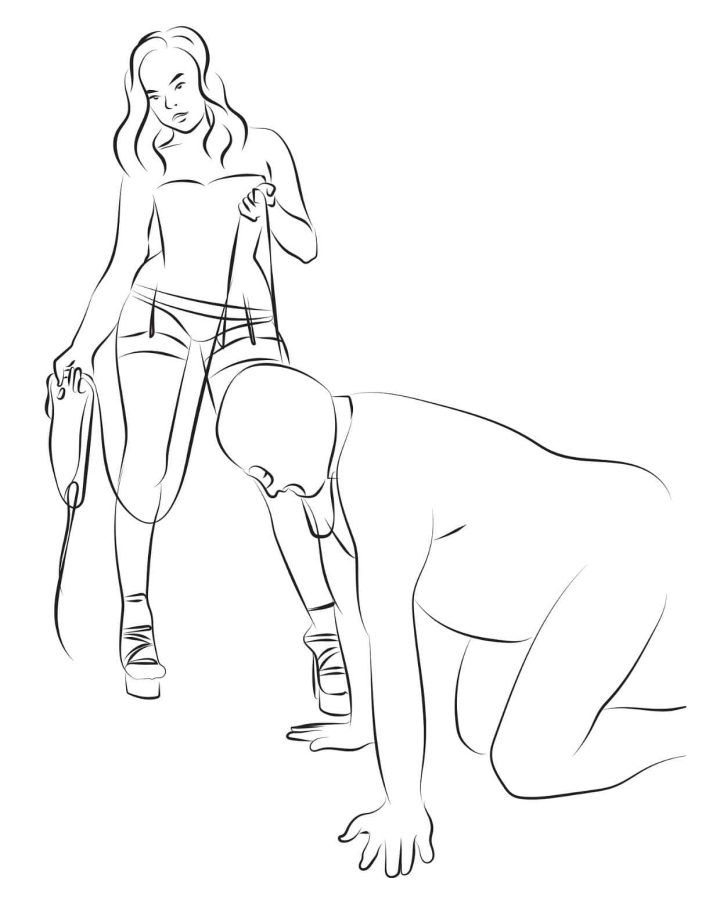Dominance and submission are two buzzwords around BDSM and in pop culture, you probably have come across before.
From Hollywood movies like 50 Shades of Grey to literature and even social media, it seems everyone gets super excited (or put off) by the concept of Ds.
Let’s shed some light on what dominance and submission are, what they entail, and how you can get started with all of it.
What is Dominance & Submission in BDSM?
Dominance & submission (Ds) is a set of consensual practices, rituals, and behaviors in BDSM where one partner takes up the dominant or controlling role, and the other the submissive one. This may include power exchange dynamics, roleplaying, obedience, punishments, and other sexual or psychological activities.
BDSM entails many different practices and kinks, and dominance and submission is just one part of it.
However, many BDSM practitioners include Ds aspects into their sexual activities regularly, while sadomasochism (enjoying inflicting or experiencing pain) and bondage (artful or sexual restriction of movement) are more specialized.
For example, when one partner spanks the other with a flogger or paddle, this is usually done by the dominant part, with the submissive one on the receiving end.
On the other hand, dominance and submission may be done without inflicting any pain.
As such, many people view Ds as the foundation of their kinky desires on which all others build on.

As is often the case with BDSM, due to the subjective manner of what is considered dominant or submissive behavior, my general advice and guideline is:
It is BDSM, when you want it to be BDSM.
Dominance & Submission Activities
It is important to note that there are no clear definitions on what falls under the category of DS and it can also be somewhat of an umbrella term.
Just because you like to be told what to do during sex doesn’t necessarily mean you practice Ds…but it could very well be just that!
Dominance and submission is also about more than just sex. Therefore, people who like rough sex, for example, might not engage further in Ds activities.
Dominance and submission are often subtle and ritualistic. Some might even go as far as to say, Ds happens anytime but during sex, although that is a rather obscure in my opinion.
Here are a few common examples of consensual dominance and submission activities and practices:
- Power exchange between partners during sex
- Domestic servitude or consensual slavery
- Rituals or trained behavior
- Corporal punishment (spanking, whipping, etc.)
- Wearing a collar or other markings
- Verbal and physical humiliation
- Rough sex
- Honorary or degrading titles for either partner
- Enforced/denied orgasm
Once again we see that Ds includes a lot of different activities and what feels very dominant to one person, could be totally different to another.
If you need some inspiration, use our FREE random punishment generator to get some ideas!
What is a Top/Dom/Master in BDSM?
Top is the term for the person controlling a BDSM scene and subsequently the submissive partner through commands, physical force, or other means. Dom or Master is usually reserved for the permanent dominant partner in a Ds-relationship who is thereby simultaneously a top.
So if you feel dominant toward your partner, in the bedroom or anywhere else, you could fit the description and role of a Top or Dom in Ds.
A few things to ask yourself to determine whether you are a dominant:
- Do I like to have control during sex?
- Am I excited by the thought that my partner obeys my commands?
- Do I naturally command respect and joyful obedience by others?
- Would I feel aroused by having my partner call me honorary titles?
- Do I like to punish my partner for disobeying me after receiving their consent?
If you can answer yes to a couple or all of these questions, you might enjoy Ds activities as a Dom. You can also ask your partner what they think and whether they view you the same way.
A few words to the terminology:
You’ll often find that people mix up these terms or use them synonymously, although technically this is incorrect.
In a DS relationship, tops are often referred to as Dom or Domme for females and it is more of an honorary title than just a description.
On the other hand, Master or Mistress is the term often given to dominant partners in a master-slave relationship, essentially a more extreme type of power exchange dynamic.

In literature and the BDSM community, it is customary to spell names and titles of the dominant partner with a capital first letter (as opposed to a lowercase letter for the submissives).
Other titles exist and the dominant partner may also be called or referred to as sir, madam, sire, miss, lady, or others.
There are different subcategories of Doms out there like Daddy Doms, Pleasure Doms, or Caregiver.
It’s important to keep in mind that being a Dom is an extremely powerful role to take up over another person and comes with A LOT of responsibility.
Remember:
Just because you call youself a Dom, does not make you one.
There are many people out there, especially on kinky dating sites and at play parties who call themselves Doms…or even Super Doms. Just looking at their behavior and the way they approach the subject clearly shows they are not made to be what they claim.
There is more to being a Dom than taking a black and white photo of you in a suit and armchair or waving around a whip.
Here are a few things that make a good dominant partner in Ds:
- Knows his/her responsibility
- Empathetic & caring
- Is a good communicator
- Respects the sub’s boundaries
- Knows when to stop a scene
- Rarely uses punishments
- Carries out appropriate aftercare
What is a bottom/sub/slave?
Bottoms are the submissive part in a BDSM scene who enjoy being controlled by and obeying the top. In DS relationships, they are referred to as subs or slaves, depending on the degree of power exchange who give up control permanently to the dominant partner.
Bottoms or submissives are, well…submissive towards their partners during sex or potentially in other situations, as well.
A few things to ask yourself to determine whether you are a submissive:
- Do I like to be controlled during sex?
- Am I excited by the thought that my partner commands me verbally or physically?
- Do I naturally want to fulfill the wishes of others/my partner in the bedroom?
- Would I enjoy being punished by my partner for disobeying them?
- Do I get aroused by being called degrading names or being treated in such a manner?
If these are things that excite you, maybe you are a born submissive.
But even if you are not sure at all, it’s okay to try it out and see for yourself. There are many people (men, women, and others) who never feel their submissive side until they meet the right person who is dominant toward them.
Similar to the concept of Tops vs Doms, the same nomenclature exists for the submissive parts in Ds.
Bottoms are the ones being controlled during the scene and are referred to as subs in relationships.
However, there are also those who enjoy being bottom (meaning someone else is in charge during sex) but explicitly not a sub, indicating that they do not like to be controlled verbally or outside of the bedroom.
Finally, slaves are the submissive partners in stricter master-slave relationships. However, especially in North America, the terms sub and slave are often used synonymously.

There are lots of different subcategories of subs out there such as brats, degradees, or littles.
In literature and the BDSM community, it is customary to spell names and titles of the submissive partner with a lowercase first letter (as opposed to an uppercase first letter for the dominants).
Being submissive is different from enjoying to give up control during sex every now and then.
Once again a reminder:
Just because you like to be told what to do sometimes, doesn’t qualify you as a sub.
Here are a few things that make a good submissive partner in Ds:
- Knows his/her responsibility
- Loyal & trustworthy
- Can communicate boundaries clearly
- Enjoys serving and obeying
- Doesn’t try to lead a scene from below (so-called “topping from the bottom“)
- Follows rules set within the limits & boundaries
What is a switch?
A switch in BDSM enjoys both the dominant, as well as the submissive part at times and can be a Top in one situation and Bottom in the other. They can also always be one or the other with certain people, or switch back and forth constantly with others.
Switches are a peculiar type in dominance and submission, as they may fit either description of dominant or submissive, or none at all.
There are many ways of how switches live out their Ds desires and fantasies and there is no one fits all way.
Some people are either Dom or sub with one partner and the opposite with others. In other cases, a person might switch back and forth between the two with the same person.
Last but not least, some people are dominant/submissive for a long time before feeling they want to be submissive/dominant now for a while or until they switch back
Remember:
Feeling neither dominant nor submissive does not make you a switch. Feeling both at the same or different times makes you a switch.
DS Equipment & Accessories
Dominance and submission does not require any special equipment or accessories. However, there are some items that often find a place in it and are commonly associated with Ds-play.

Collar
The most notable and (in)famous accessory in BDSM is arguably the collar.
It is worn by the submissive part in Ds-relationships, or the Bottom in a scene, and signifies their obedience towards the Dom, as well as their status as a sub.
In other cases, people simply enjoy the aesthetics of it and it has no further meaning.
Different styles and materials are used such as leather, metal, with or without extra lock, round, sharp edges, and varying colors.
Some people enjoy hooking up a leash to the collar to lead the submissive around, while other collar types are very small and subtle and can be worn as an everyday-like piece of jewelry.
In some BDSM circles, Ds -couples celebrate the reception of a personal(ized) collar with a so-called “collaring ceremony” which is similar to a kinky-style wedding almost.
Whips, floggers, canes etc.
Spanking utensils such as whips, floggers, or canes often (but not always) find plenty of use in dominance and submission play.
While spankings and other consensual corporal punishments are often carried out, they can also be utilized in combination with other SM (sadomasochistic) practices just for pleasure.
At BDSM parties and gatherings, Doms often carry such items to indicate their status or simply for aesthetic reasons.
Chains, ropes, leashes
Chains, ropes, and leashes often work hand in hand with the collar to lead the submissive or restrain them in light or advanced bondage.
What is a Ds-Relationship?
In a Ds-relationship, consensual power exchange between partners takes place regularly, or indefinitely in a committed relationship. The roles of Dom and sub are often fixed and never change. In some cases, BDSM only plays a role in the bedroom, while others let it influence their everyday life.
Ds-relationships are usually different from relationships between partners who like to incorporate some dominance and submission in the bedroom occasionally.
Usually, Ds-relationships are committed and/or loving relationships between partners in which BDSM is regularly practiced in the bedroom and potentially outside.
Note that these partners don’t need to necessarily be each other’s primary partners, and some have a Dom or sub outside their normal relationship.
As you’ll see below, there are many different types of Ds-relationships, based on the rules, rituals, and kinks of the participating partners.
In most cases, there is one permanent Dom and one permanent sub and these roles never change. In some rare cases, especially between switches, the power exchange dynamic may be more fluid.
Types of Ds-Relationships
Here are some of the most common types of Ds relationships. Please note that Dom/sub can refer to either men, women, or anyone else, except for certain cases when it is marked as such.
Dom/sub
The classic type of Ds-relationship between Dom and sub in which the roles never change. BDSM is practiced regularly, but there is a clear separation between everyday life and kinky play.
Master/slave
A Master/slave relationship is essentially a Dom/sub one, except that the control of the dominant partner is much tighter and more absolute.
The lines are often fluid between the two, but it can be said that subs are usually still expected to be opinionated about certain things, or act in a way they see fit when there is no fixed rule for it. Slaves, on the other hand, are usually governed by very strict rules that leave no room for interpretation.
24/7
A subtype of all other Ds-relationships in which the power exchange dynamic does not end when a scene or session is over. Instead, dominance and submission is carried over into everyday life through the use of rituals, rules, trained behavior, or other means.
The way 24/7 is lived out varies from relationship to relationship and some are stricter than others.
For example, some Dom/sub couples incorporate a power exchange dynamic into all parts of life which is then called TPE (total power exchange) while others leave out sensitive areas like work, finance, or family.
TPE – Total power exchange
The most extreme form of a 24/7 Ds-relationship in which one partner has consensually been given power over all aspects of life of the other.
This is a rare phenomenon and even people who call themselves to be in a TPE relationship still apply certain boundaries in most cases.
Daddy-little
Age play or variations thereof are a common fetish or kink and lived out in so-called Daddy-little relationships.
Daddy or Daddy-Dom is the dominant part which also acts as a protector for the little who likes to be caressed and experience a strong sense of care of the Dom.
This is usually (but not exclusively) seen in relationships between a dominant man and a submissive woman with a larger age gap between them.
FLR – Female-led relationship
Although Dom or sub may refer to any gender or sex, some like to point out the fact when a woman is the dominant partner by calling it an FLR or female-led relationship.
Cuckold/hotwife
Cuckold/hotwife relationships are a type of FLR in which the man gets pleasure from sharing his partner, the hotwife, with another man while being chastised or humiliated.
In some cases, chastity can become a permanent state in which the primary partners in the FLR don’t have sex with each other anymore. This is called “never inside” and is considered a fetish just as much as BDSM.
Online Ds
With the rise of dating apps and online forums, there are more and more online Ds-relationships between people who may or may not have met in real life before.
Such connections may evolve into online Ds-relationships which include dominance and submission play via webcam or phone.
How to get started with Dominance & Submission play
Get started with dominance and submission play by openly talking with your partner and sharing your fantasies, desires, and wishes. Start out slow with light Ds play and move on to other activities once you are confident enough. It’s all about having fun together!
Getting started with dominance and submission is not hard, nor does it require any training. Nevertheless, many people find it very difficult to open up about it to their partners.
Here are 7 steps to get started with dominance and submission in your life:
- Think about why you want to try out Ds
- Find inspiration online or from books about BDSM
- Make a list of your fantasies and desires
- Talk to your partner about it / Find a partner to try it out with
- Find common desires and wishes
- Set clear boundaries
- Go and have fun!
1 Think about why you want to try out Ds
Ask the question of why dominance and submission intrigue you. Is it the thrill of controlling your partner during sex? Would you like to get tied up with rope? Do you fantasize about spanking your partner?
Or perhaps you read about it in a book or your friend told you about it.
No matter what it is, these are all good and valid reasons to start with Ds. Knowing the reasons can help you decide what to try out first.
2 Find inspiration online or from books about BDSM
There are plenty of books, movies, and online resources for BDSM.
If you have enough ideas of your own you don’t necessarily need them, but it can be great source of inspiration.
3 Make a list of your phantasies and desires
Many people find it very helpful to write down what they want to try out or the desires they have.
Not only is it a great way to reflect on it, but also helps your partner if you share it with them.
In the BDSM community and on online dating platforms, it is common to exchange so-called “kink lists” or “BDSM lists” before meeting a potential play partner.
4 Talk to your partner about it / Find a partner to try it out with
Communication is key!
Tell you partner what has been on your mind and what you would like to do with them.
It can be a daunting task to talk about sex and BDSM but don’t worry. Your partner will be thankful that you trust them enough.
And who knows? There is a good chance they have been thinking about exactly the same! 😉
What to do if you do not have a partner yet?!
Tricky but not impossible and just as exciting!
If you don’t have a partner to try out Ds, there are many ways to find potential BDSM play partners.
Check out the best BDSM dating sites in 2025 for inspiration!
5 Find common desires and wishes
Once you spoke to your partner, it is time to decide if and what to try out first in dominance and submission.
Are you already decided on who should be the dominant and submissive partner? From experience, this is the case in most relationships naturally, while others need some time to decide for themselves.
Next up is finding common grounds on what you want to do and how to do it.
Do you want to get spanked? Would you like to see your partner on their knees in the bedroom next time?

6 Set clear boundaries
Setting boundaries is super important for anyone trying out Ds for the first time!
Boundaries are also called “limits” in BDSM jargon and there are different kinds:
Soft limits are those kinks you might not be super comfortable with all the time but on other occasions it’s okay.
Hard limits are practices you absolutely never want to do/try out and must not be attempted by your partner.
It can be a good idea to write down these limits so everyone is clear on them. This is especially important when dating new kinky people!
7 Go and have fun!
BDSM and Ds are about fun. Once you talked about it long enough it’s time to go and have fun!
Safety in Dominance and Submission
Safety is the number one concern in dominance and submission and the first rule and guideline is always:
Don’t engage in any sexual or BDSM practices without first asking for consent from everyone involved!
Consent is key and you need to actively get consent from your partner first.
Here are a few more safety tips for dominance & submission activities:
- Consent comes first
- Start out slow
- Everyone is different
- Have a safeword
- Try out one new thing at a time
- Respect boundaries
- Treat everyone with respect
- Don’t neglect aftercare
Start out slow
Whether you are playing with a new or old partner or trying out BDSM and Ds for the first time, you should start out slowly. Leave the extreme or challenging practices for when you are confident and more experienced.
Everyone is different
One person’s magic drink can be another one’s kryptonite. This means, what works for one person doesn’t necessarily work for anybody else and every time you meet someone new, you should not assume they enjoy the same kinks as you.
Have a safeword
A safeword is a phrase or word to be called by the sub or Dom to immediately end the scene. It’s arguably the single most important safety measure in BDSM and you absolutely need to respect it.
Try out one new thing at a time
Some people can experience cognitive, emotional, or physical overload from certain Ds practices, especially the more extreme ones like degrading or harsh punishments.
It is important to only try one new thing at a time, so as to not overdo it in one session.
Respect boundaries
Boundaries exist for a reason and limits are NOT there to be broken (unlike some rules…hehe).
Disrespecting boundaries is an immediate red flag and if you encounter someone who behaves like that…get far away from them!
Treat everyone with respect
Everyone deserves the same respect! Doms, subs, kinksters, non-kinksters…never make the mistake to disrespect anyone based on their BDSM role or position.
Interacting with other subs
Treat subs of other Doms or Dommes respectful and like a normal person. Just because they are someone’s sub doesn’t make them YOUR sub!
Don’t neglect aftercare
Aftercare should be done after every scene or whenever you carried out any Ds practices. Sit or lay together, cuddle or talk about your experiences and bring each other back to reality.

Dominance & Submission Terminology
To recap, here is the most important terminology in dominance and submission that you might come across:
Ds – Abbreviation for dominance & submission
Top – The person in charge of controlling a BDSM scene
Bottom – The person being controlled or on the receiving end during a BDSM scene
Dom – The dominant partner in a Ds-relationship or connection, often synonymous with Top
Sub – The submissive partner in a Ds-relationship or connection, often synonymous with Bottom
Domme – A female Dom (or Top)
Master – Dominant part in a Master/slave relationship (sometimes synonymous with Dom)
Slave – Submissive part in a Master/slave relationship, expected to fulfill any and every command by their Master
Switch – Someone who enjoys to be both in a Top or Bottom position
Dominatrix – A female professional Domme that offers BDSM-related services to clients
Scene/session – Common term for the time spent on Ds-activities.
DS relationship – Relationship in which Ds practices may be implemented beyond the bedroom
24/7 – Type or Ds-relationship in which one partner is in control of the other in many (or all) parts of life, even outside the bedroom
TPE – Total power exchange: Relationships in which the Dom holds all power in all aspects of life in a DS relationship
Femdom – Umbrella term for power exchange dynamics in which a female is in charge.
FLR – Female Led Relationship – Type of Ds relationship between a Domme and her sub or slave
Safeword – Phrase or word to be called by either party to stop a scene or session instantly.
Aftercare – The time immediately after a scene in which dominant and submissive partner should comfort each other to calm down and bring each other “back to reality”.